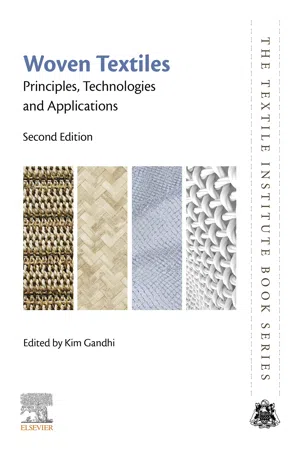1.1 Introduction
Woven fabrics consist of interlacements of yarns in two mutually perpendicular directions. Their structure permits a variation in the length and distribution of interlacements, resulting in a range of fabric deformations. Such control also offers scope for the generation of a diverse range of patterns and properties in fabrics. Triaxial fabrics are a special class of woven fabrics in which the warp threads constitute two sheets inclined at different angles, instead of being vertical. The weft thread is interlaced horizontally with the warp; this configuration thus has yarns in the fabric in three axes, hence the term ‘triaxial’ fabrics.
The building block of a woven fabric is yarn but the basic unit is fibre. Strength, extension, fineness, length, and surface properties are some of the primary attributes of fibres which, using different types or blends of fibres, create a wide spectrum of useful and desirable physical and mechanical properties in the yarn and fabric produced. There are two basic types of fibres or filaments used in yarn:
- • discontinuous fibres, that is, short/staple fibres (including most natural fibres); and
- • continuous fibres (such as silk and synthetic fibres).
Natural fibres have traditionally offered a variety of physical and mechanical properties. Using a natural, regenerated, and synthetic filament yarn increases the range of physical and mechanical properties available and, indeed, allows functional properties to be tailor-made for a particular end use. Man-made filaments can be modified by texturing to alter bulk or stretch, or cut to the desired length to produce staple fibres which, either alone or blended with other fibres, are then blended as spun yarns. Knowledge of fibre properties enables a design engineer to select the proper materials to create fabrics for specific end uses.
1.2 Types of natural and regenerated fibres
Cotton, wool, flax, and silk are the most important natural textile fibres, followed by fibres such as jute and kenaf. Natural fibres vary in length and in their other properties. They are not consistent and contain unwanted impurities from their original source. Such fibres need to be processed to remove these impurities and reduce the variation in their length. Such fibres can be made coherent, continuous, and load bearing by providing sufficient twist to the strand.
The mechanical properties of silk fibres are a combination of high strength, extensibility, and compressibility. Jute and kenaf are strong fibres, exhibiting brittle fracture and with a small extension at break; they have high initial modulus but show very little recoverable elasticity. Cotton is the most important natural cellulosic textile fibre. Length and fineness are important measures of fibre quality. Cotton fibres range in dimensions from a length of 5–1.5 cm and a linear density of 1–3 dtex. Amongst its many important properties, cotton fibre is hydrophilic and porous; on immersion in water, it swells and its internal pores fill with the water. Chemical modification can add many desired properties to a cotton fabric, including colour, permanent press, flame resistance, soil release, and antimicrobial properties.
Regenerated fibres are manufactured from natural polymers. Two of the most widely used regenerated fibres are rayon and acetate. There is a wide variety of different rayon fibres, including regular rayons, high-tenacity rayons, low wet modulus rayons, high wet modulus and modal rayons, high-strength/high-elongation rayons, polynosic rayons, flame-retardant rayons, high absorbency (alloy rayons), hollow rayons, and cuprammonium rayons. High-tenacity rayons are used where strength, toughness, and durability are required. These fibres are dimensionally stable when used as reinforcement in tyres, conveyor belts, drive belts, and hoses. Other applications for this type of rayon include industrial sewing threads, tent fabrics, and tarpaulins.
A range of cross-sectional shapes such as round, flat, Y-shaped, E-shaped, U-shaped, T-shaped, and irregular ...
